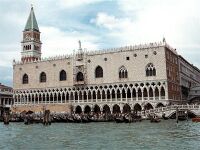Palazzo Ducale: Difference between revisions
No edit summary |
|||
| Line 43: | Line 43: | ||
==See Also== | ==See Also== | ||
{{Template:MuseumNav}} | {{Template:MuseumNav}} | ||
Revision as of 13:42, 16 December 2012
| Palazzo Ducale | |
|---|---|
 | |
| Address | San Marco 1, 30124 Venice |
| Website | http://palazzoducale.visitmuve.it/en |
| Ticket Price |
€16,00 full priced €10,00 reduced price (grants entry into all St. Mark's Square Museums) |
| Hours of Operation |
1 April - 31 October, 8:30am - 7:00pm 1 November - 31 March, 8:30am - 5:30pm (closed on 31 December and 1 January) |
The Ducal Palace was the residence of the Doge up until the fall of the Venetian Republic in I797 when it became a public palace and seat of the administration of justice - the highest and richest symbol of Venetian civilization. As well as being the ducal residence, the palace housed political institutions of the Republic of Venice until the Napoleonic occupation of the city. Venice was ruled by an aristocratic elite, but there was a facility for citizens to submit written complaints at what was known as the Bussola chamber.
Its two most visible facades look towards the Venetian Lagoon and St Mark's Square, or rather the Piazzetta. The use of arcading in the lower stories produces an interesting "gravity-defying" effect. There is also effective use of colour contrasts.
Museum
The building is preserved as a museum. In the palace, all historic periods are represented in an extraordinary stratification of structural and decorative elements: from the antique foundations of the original Gothic complex, to the great halls dedicated to political life and decorated by the canvases of Veronese; from Tintoretto and the great masters of the Renaissance. to the precious rooms of the Doges apartment; from the dark prisons and places of torture to the luminous loggias on the Piazza and the Lagoon. Inside the visitor can see paintings by Tintoretto and Paolo Veronese Veronese, which glorify the Venetian state. In 2007 there was a temporary exhibition on "Venice and Islam".
Construction and Reconstruction
The current palace was largely constructed from 1309 to 1424, designed perhaps by Filippo Calendario. It replaced previous fortified buildings about which relatively little is known. Giovanni Bon Giovanni and Bartolomeo Bon created the Porta della Carta in 1442, a monumental late-gothic gate on the Piazzetta side of the palace. This gate leads to a central courtyard.
The palace was damaged by fire in 1574. During the subsequent rebuilding work, it was decided to respect the original gothic style, despite the submission of a neo-classical alternative design by Palladio. There are some classical features, however. For example, since the sixteenth century, the palace has been linked to the prison by the Bridge of Sighs.
-
Doge's Palace
-
Doge's Palace
See Also
| ||||||||||||||||||||
References
NULL

